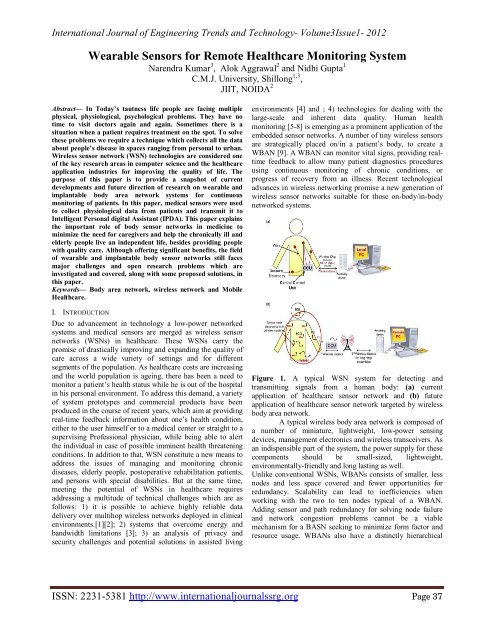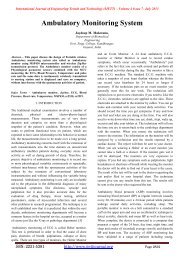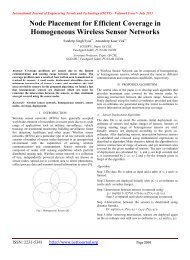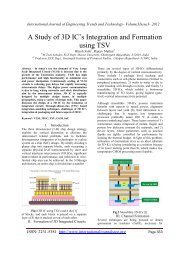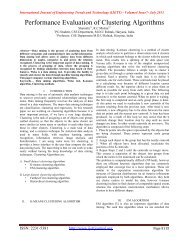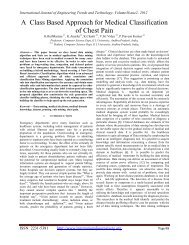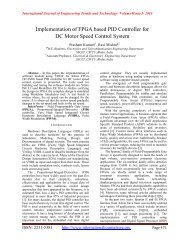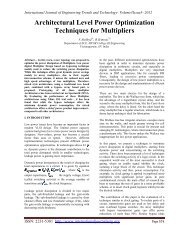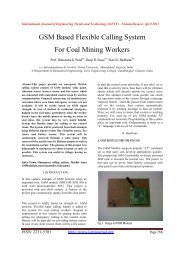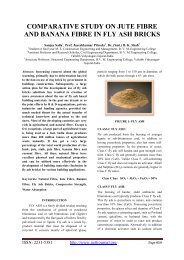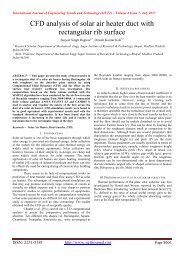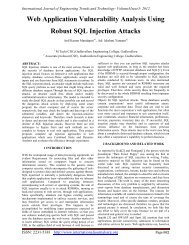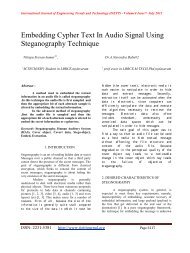Wearable Sensors for Remote Healthcare Monitoring System
Wearable Sensors for Remote Healthcare Monitoring System
Wearable Sensors for Remote Healthcare Monitoring System
You also want an ePaper? Increase the reach of your titles
YUMPU automatically turns print PDFs into web optimized ePapers that Google loves.
International Journal of Engineering Trends and Technology- Volume3Issue1- 2012<br />
<strong>Wearable</strong> <strong>Sensors</strong> <strong>for</strong> <strong>Remote</strong> <strong>Healthcare</strong> <strong>Monitoring</strong> <strong>System</strong><br />
Narendra Kumar 3 , Alok Aggrawal 2 and Nidhi Gupta 1<br />
C.M.J. University, Shillong 1,3 ,<br />
JIIT, NOIDA 2<br />
Abstract— In Today’s tautness life people are facing multiple<br />
physical, physiological, psychological problems. They have no<br />
time to visit doctors again and again. Sometimes there is a<br />
situation when a patient requires treatment on the spot. To solve<br />
these problems we require a technique which collects all the data<br />
about people’s disease in spaces ranging from personal to urban.<br />
Wireless sensor network (WSN) technologies are considered one<br />
of the key research areas in computer science and the healthcare<br />
application industries <strong>for</strong> improving the quality of life. The<br />
purpose of this paper is to provide a snapshot of current<br />
developments and future direction of research on wearable and<br />
implantable body area network systems <strong>for</strong> continuous<br />
monitoring of patients. In this paper, medical sensors were used<br />
to collect physiological data from patients and transmit it to<br />
Intelligent Personal digital Assistant (IPDA). This paper explains<br />
the important role of body sensor networks in medicine to<br />
minimize the need <strong>for</strong> caregivers and help the chronically ill and<br />
elderly people live an independent life, besides providing people<br />
with quality care. Although offering significant benefits, the field<br />
of wearable and implantable body sensor networks still faces<br />
major challenges and open research problems which are<br />
investigated and covered, along with some proposed solutions, in<br />
this paper.<br />
Keywords— Body area network, wireless network and Mobile<br />
<strong>Healthcare</strong>.<br />
I. INTRODUCTION<br />
Due to advancement in technology a low-power networked<br />
systems and medical sensors are merged as wireless sensor<br />
networks (WSNs) in healthcare. These WSNs carry the<br />
promise of drastically improving and expanding the quality of<br />
care across a wide variety of settings and <strong>for</strong> different<br />
segments of the population. As healthcare costs are increasing<br />
and the world population is ageing, there has been a need to<br />
monitor a patient’s health status while he is out of the hospital<br />
in his personal environment. To address this demand, a variety<br />
of system prototypes and commercial products have been<br />
produced in the course of recent years, which aim at providing<br />
real-time feedback in<strong>for</strong>mation about one’s health condition,<br />
either to the user himself or to a medical center or straight to a<br />
supervising Professional physician, while being able to alert<br />
the individual in case of possible imminent health threatening<br />
conditions. In addition to that, WSN constitute a new means to<br />
address the issues of managing and monitoring chronic<br />
diseases, elderly people, postoperative rehabilitation patients,<br />
and persons with special disabilities. But at the same time,<br />
meeting the potential of WSNs in healthcare requires<br />
addressing a multitude of technical challenges which are as<br />
follows: 1) it is possible to achieve highly reliable data<br />
delivery over multihop wireless networks deployed in clinical<br />
environments.[1][2]; 2) systems that overcome energy and<br />
bandwidth limitations [3]; 3) an analysis of privacy and<br />
security challenges and potential solutions in assisted living<br />
environments [4] and ; 4) technologies <strong>for</strong> dealing with the<br />
large-scale and inherent data quality. Human health<br />
monitoring [5-8] is emerging as a prominent application of the<br />
embedded sensor networks. A number of tiny wireless sensors<br />
are strategically placed on/in a patient’s body, to create a<br />
WBAN [9]. A WBAN can monitor vital signs, providing realtime<br />
feedback to allow many patient diagnostics procedures<br />
using continuous monitoring of chronic conditions, or<br />
progress of recovery from an illness. Recent technological<br />
advances in wireless networking promise a new generation of<br />
wireless sensor networks suitable <strong>for</strong> those on-body/in-body<br />
networked systems.<br />
Figure 1. A typical WSN system <strong>for</strong> detecting and<br />
transmitting signals from a human body: (a) current<br />
application of healthcare sensor network and (b) future<br />
application of healthcare sensor network targeted by wireless<br />
body area network.<br />
A typical wireless body area network is composed of<br />
a number of miniature, lightweight, low-power sensing<br />
devices, management electronics and wireless transceivers. As<br />
an indispensible part of the system, the power supply <strong>for</strong> these<br />
components should be small-sized, lightweight,<br />
environmentally-friendly and long lasting as well.<br />
Unlike conventional WSNs, WBANs consists of smaller, less<br />
nodes and less space covered and fewer opportunities <strong>for</strong><br />
redundancy. Scalability can lead to inefficiencies when<br />
working with the two to ten nodes typical of a WBAN.<br />
Adding sensor and path redundancy <strong>for</strong> solving node failure<br />
and network congestion problems cannot be a viable<br />
mechanism <strong>for</strong> a BASN seeking to minimize <strong>for</strong>m factor and<br />
resource usage. WBANs also have a distinctly hierarchical<br />
ISSN: 2231-5381 http://www.internationaljournalssrg.org Page 37
International Journal of Engineering Trends and Technology- Volume3Issue1- 2012<br />
nature. They capture large amount of data constantly and<br />
naturalistically that microprocessors should process to extract<br />
the needed in<strong>for</strong>mation. Data processing must be hierarchical<br />
to exploit the asymmetry of resources, to maintain system<br />
efficiency, and ensure the availability of data, if necessary<br />
[10].<br />
3. <strong>System</strong> Architecture of BAN<br />
This section describes the system architecture of the proposed<br />
wearable sensors <strong>for</strong> remote healthcare monitoring system.<br />
The system is composed of three tiers as shown in Figure 2<br />
below.<br />
The system composed of:<br />
1) Wireless Body Area Network (WBAN);<br />
2) Personal Server (PPS) using IPDA;<br />
3) Medical Server <strong>for</strong> <strong>Healthcare</strong> <strong>Monitoring</strong> (MSHM).<br />
Figure 3 Architecture of wearable sensors <strong>for</strong> remote<br />
healthcare monitoring system<br />
3.1. First Tier<br />
The core of this system is the user called the patient. <strong>Wearable</strong><br />
sensors are attacked to the patient body <strong>for</strong>ming wireless body<br />
area network (WBAN) to monitor changes in patient’s vital<br />
signs closely and provide real time feedback to help maintain<br />
an optimal health status. The medical sensors typically consist<br />
of five main components:<br />
1) Sensor: it is a sensing chip to sense physiological data<br />
from the patient’s body.<br />
2) Microcontroller: it is used to per<strong>for</strong>m local data<br />
processing such as data compression and it also controls the<br />
functionality of other components in the sensor node.<br />
3) Memory: it is used to store sensed data temporally.<br />
4) Radio Transceiver: it is responsible <strong>for</strong> communication<br />
between nodes and to send/receive sensed physiological data<br />
wirelessly.<br />
5) Power supply: the sensor nodes are powered by<br />
batteries with a lifetime of several months [11].<br />
Sensor nodes can sense, sample, and process one or more<br />
physiological signals. For example, an electro- cardiograph<br />
(EKG) sensor can be used <strong>for</strong> monitoring heart activity, a<br />
blood pressure sensor can be used <strong>for</strong> monitoring blood<br />
pressure, a breathing sensor <strong>for</strong> monitoring respiration, an<br />
electro-myogram (EMG) sensor <strong>for</strong> monitoring muscle<br />
activity, and an electroenphalogram (EEG) sensor <strong>for</strong><br />
monitoring brain electrical arrive <strong>for</strong> each sensor.<br />
In our design, a sophisticated sensor is integrated into the<br />
WBAN called Medical Super Sensor (MSS). This sensor has<br />
more memory, processing and communication capabilities<br />
than other sensor nodes .MSS uses a radio frequency to<br />
communicate with other body sensors and ZigBee is used as a<br />
communication protocol to communicate with the Personal<br />
Server.<br />
Medical Super-Sensor (MSS) unobtrusively samples,<br />
collects multiple sensed vital signs by the body sensors,<br />
filtering out all redundant data thereby reducing large volume<br />
of data transmitted by BSNs, store them temporarily, process<br />
and transfer the relevant patient’s data to a personal server<br />
through wireless personal implemented using ZigBee/IEEE<br />
802.15.4. This improves overall bandwidth utilization as well<br />
as reducing power consumption of the BSs because each<br />
nodes does not need to transmit sensed data to the IPDA but to<br />
the cool-lector which is MSS and it is closer to the BSs than<br />
IP-DA and extending battery life of each sensor node.<br />
3.2. Second Tier<br />
Personal Server<br />
The personal server interfaces the WBAN nodes through a<br />
communication protocol using ZigBee. It is implemented on<br />
an Intelligent Personal Digital Assistant (IPDA). It holds<br />
patient authentication in<strong>for</strong>mation and is configured with the<br />
medical server IP address in order to interface the medical<br />
services. It collects physiological vital signals from WBAN,<br />
processes them, and prioritizes the transmission of critical<br />
data when there is sudden clinical change in the current<br />
patient condition and data content <strong>for</strong> example changes in<br />
cardiovascular signals, temperature, oxygen saturation, and<br />
<strong>for</strong>ward it to the medical server.<br />
Moreover, the IPDA has the capability to per<strong>for</strong>m the task<br />
of analyzing the physiological data intelligently and do a local<br />
reasoning to determine user’s health status based on data<br />
received from MSS and provide feedback through a userfriendly<br />
and interactive graphical user interface. 3G<br />
communications is used to connect personal server and third<br />
tier together but other long range communications protocols<br />
can also be used like GPRS, WWAN.<br />
In order <strong>for</strong> IPDA to improve the overall quality of service<br />
<strong>for</strong> data transmission, in terms of latency, band-width and<br />
power consumption a differentiated service based on two<br />
schemes are presented. They are Priority Scheduling and Data<br />
ISSN: 2231-5381 http://www.internationaljournalssrg.org Page 38
International Journal of Engineering Trends and Technology- Volume3Issue1- 2012<br />
Compression. This method reduces energy consumed by the<br />
IPDA during transmission since only the critical vital signs<br />
will transmit first while less critical signs are stored and<br />
transmit later.<br />
IPDA is inactive mode when it has no data to receive from<br />
MSS or send to the medical server in order to save energy but<br />
wake up immediately from inactive to active mode to receive<br />
transmitted data and store it. It prioritizes all the received<br />
physiological data and send to the medical server based on the<br />
priority order so that the medical staff will be adequately<br />
prepared be<strong>for</strong>e the patient gets to them or send ambulance<br />
immediately to pick the patient so as to save his/her life.<br />
3.3 Medical Server <strong>for</strong> <strong>Healthcare</strong> <strong>Monitoring</strong> (MSHM).<br />
The third tier is called Medical Server <strong>for</strong> <strong>Healthcare</strong><br />
<strong>Monitoring</strong> (MSHM). It receives data from the personal<br />
server, is the backbone of the entire architecture. It is situated<br />
at medical centers where medical services are provided. It is<br />
intelligent because it is capable of learning patient specific<br />
thresholds and learns from previous treatment records of a<br />
patient [12]. MSHM keeps electronic medical records (EMRs)<br />
of registered patients, which are accessible by different<br />
medical staff, including general practitioners, specialists and<br />
doctors from their offices in the hospital over the internet. The<br />
present state of the patient can be observed by the medical<br />
staff. MSHM is responsible <strong>for</strong> user authentication, accepting<br />
data from personal server, <strong>for</strong>mat and insert the received data<br />
into corresponding EMRs, analyze the data patterns.<br />
The patient’s physician can access the data and its patterns<br />
from his/her office via the intranet/internet and examine it to<br />
ensure the patient is within expected health metrics. If the<br />
received data is out of range (i.e. deviation from threshold) or<br />
recognize serious health anomalies condition, medical staff in<br />
the emergency unit can be notified to take necessary actions.<br />
However, if the patient is in the remote area, the specialist<br />
doctor will observe the physiological data of the patient<br />
diagnose it, prescribe the necessary treatment and drugs <strong>for</strong><br />
the patient. This in<strong>for</strong>mation will sent back to the doctor in the<br />
remote hospital via the internet. The MSHM also provides<br />
feedback instructions to the patient, such as physician’s<br />
prescribed exercises.<br />
In this paper, the current state in research and development of<br />
wearable low-cost unobtrusive systems <strong>for</strong> health-monitoring<br />
is reviewed by summarizing and comparing the attributes of<br />
the most promising current achievements of several<br />
worldwide projects and commercial products. Section II<br />
presents the most important and widely employed biosensor<br />
technologies along with the corresponding measured<br />
biosignals.<br />
II. PHYSIOLOGICAL SIGNALS AND BIOSENSORS<br />
This section provides a list of several sensing technologies as<br />
depicted in Table I, which can be integrated as part of a<br />
wearable health-monitoring system, along with their<br />
corresponding measured physiological signals. The<br />
measurement of these vital biosignals and their subsequent<br />
processing <strong>for</strong> feature extraction, leads to a collection of realtime<br />
gathered physiological parameters, which can give an<br />
overall estimation of the user’s health condition at any given<br />
time.<br />
Type of Sensor<br />
Skin/Chest Electrode<br />
Arm-cuff based Monitor<br />
Piezoelectric Sensor<br />
Pulse Oximeter<br />
Skin electrodes<br />
Phonocardiograph<br />
Galvanic Skin responses<br />
Strip base glucose meter<br />
Description of measured data<br />
Electrical Activity of heart<br />
Blood circulation in arteries<br />
Breathing rate<br />
Amount of oxygen in blood<br />
Frequency of cardiac cycle<br />
Stethoscope<br />
Activity of sweat glands<br />
Amount of Glucose in blood<br />
4. BAN Applications to <strong>Healthcare</strong> Promotion<br />
Current healthcare applications of wireless sensor networks<br />
target heart problems [13,15,16], asthma[14,17,18],<br />
emergency response [19], stress monitoring [20]. The<br />
integration of existing specialized medical technology with<br />
pervasive wireless networks will be seen in the near future<br />
[21]. Medical applications benefit from wireless sensor<br />
networks in many ways. The recent advances in<br />
miniaturization of smart biosensors will open up new<br />
opportunities <strong>for</strong> continuous monitoring of patients.<br />
Nonintrusive, tiny wearable sensors will allow collection of<br />
vast amounts of data automatically, reducing the cost and<br />
inconvenience of regular visits to the physician. Thus, many<br />
more researchers may be enrolled, benefiting all research<br />
peers [22].<br />
4.1 Cardiovascular diseases<br />
Cardiovascular disease refers to various medical conditions<br />
that affect the heart and blood vessels. The conditions include<br />
heart attack, heart failure, stroke, coronary artery disease. This<br />
disease is the leading cause of mortality in the developed<br />
world [34,35].<br />
ISSN: 2231-5381 http://www.internationaljournalssrg.org Page 39
International Journal of Engineering Trends and Technology- Volume3Issue1- 2012<br />
World Heart Organization [36] stated that heart disease<br />
accounts <strong>for</strong> about 17 million (about 30%) deaths annually<br />
throughout the world and 80 percent of all deaths in China are<br />
caused by chronic disease [37] About one-half of those who<br />
die do so within 1 hour of the start of symptoms and be<strong>for</strong>e<br />
reaching the hospital.<br />
A WBAN is a key technology that provides real-time<br />
monitoring of cardiovascular patients by continuously sense,<br />
process, and transmit physiological data from central control<br />
unit to the medical server through personal server, which the<br />
physician can make use of the in<strong>for</strong>mation to treat the<br />
patients. Also promoting timely intervention of health care<br />
structure as and when required.<br />
.<br />
4.2 Cancer Detection<br />
National Centre <strong>for</strong> Health Statistics in their annual report<br />
stated that about 9 million cancer patients were diagnosed in<br />
1999 and the number is increasing every year [23]. Cancer is<br />
now one of the biggest threats to the human life. A WBAN<br />
with a set of miniaturized sensors can be used to differentiate<br />
between different types of cells and<br />
identifying cancerous cells, enabling physicians to diagnose<br />
tumors without biopsy.<br />
4.3 Alzheimer, depression, and elderly people monitoring<br />
According to the U.S. Bureau of the Census, the number of<br />
adults age 65 to 84 is expected to be doubled from 35 million<br />
to nearly 70 million by 2025. This trend is global, so the<br />
worldwide population over age 65 is expected to more than<br />
double from 357 million in 1990 to 761 million in 2025. In<br />
addition, a recent study found that almost one third of U.S.<br />
adults, most of whom held full-time jobs, were serving as<br />
in<strong>for</strong>mal caregivers mostly to an elderly parent. Wireless<br />
sensor network can help homebound and elderly people who<br />
often feel lonely and depressed by detecting any abnormal<br />
situation and alerting neighbors, family or the nearest hospital<br />
[24].<br />
4.4 Glucose Level <strong>Monitoring</strong><br />
The US national institute of health (NIH) reported 15.7<br />
million people had the emerging disease diabetes in 1999 in<br />
the US. Diabetes can yield other complicated diseases like<br />
heart disease, stroke, high blood pressure, blindness, kidney<br />
disease, and amputations. A biosensor implanted in the patient<br />
could provide a more consistent, accurate, and less invasive<br />
method by monitoring glucose levels, transmit the results to a<br />
wireless PDA or a fixed terminal, and by injecting insulin<br />
automatically when a threshold glucose level is reached [25].<br />
4.5 Asthma<br />
Millions of patients are suffering from asthma in the world,<br />
a WBAN can help these patients by monitoring allergic agents<br />
in the air and providing real-time feed-back to the physician<br />
and/or to the patient himself. A portable Global Positioning<br />
<strong>System</strong> (GPS) device was developed by Chu et al. [14] that<br />
continuously consult a remote server by sensing user’s reports<br />
to decide whether current ambient air quality will threaten<br />
user’s health. The server also collects real-time data from the<br />
network of national air quality monitoring stations. If it finds<br />
anything allergic to the patient, an alarm to the patient and/or<br />
physician will be triggered.<br />
4.6 Epileptic Seizures Strike Early Warning<br />
Strokes affect 700,000 people each year in the US and about<br />
275,000 die from stroke each year [26]. <strong>Wearable</strong> sensor<br />
system has the ability to monitor home bounded people by<br />
measuring motor behavior at home <strong>for</strong> longer time and can be<br />
used to predict clinical scores.<br />
Researchers at the University of Chicago Medical Center are<br />
developing a device called “Mobi”, using TMSI technology<br />
that could change the lives of patients who suffer from<br />
seizures. They are trying to develop an early warning<br />
algorithm <strong>for</strong> epilepsy [27]. The portable unit “Mobi” is<br />
designed to detect abnormal brain activity that happens be<strong>for</strong>e<br />
a seizure. When the signs of electrical trouble are picked up<br />
the device will transmit a warning to a receiver and the patient<br />
could then take steps to set down or tell someone. But finding<br />
an algorithm that would detect <strong>for</strong> a particular patient when<br />
the seizure is about to start is still an issue.<br />
4.7 Diabetes<br />
World Health Organization (WHO) reported that more that<br />
220 million people worldwide have diabetes and 1.1 million<br />
people died from diabetes in 2005. Following are some of the<br />
complications that occur as a result of diabetes: amputations,<br />
blindness, kidney disease, stroke, high blood pressure, heart<br />
disease [28] Treatment includes blood pressure control,<br />
exercise, insulin injections. A WBAN can be used in a more<br />
effective way to treat diabetes, by providing a more<br />
consistent, less invasive and accurate method <strong>for</strong> monitoring<br />
glucose levels in the body.[29]<br />
4.8 Artificial Retina<br />
Optoelectronic Retina Prosthesis (ORP) chips can be<br />
implanted into the back of human eye, which assist blinds<br />
and/or patients with low vision to see normally.<br />
IV Challenges Associated with BAN<br />
BAN technology is still emerging and there are a lot of<br />
problems left to solve. Setting aside ethical issues like<br />
privacy, there are still plenty of technical challenges that we<br />
must overcome be<strong>for</strong>e BAN will become an effective<br />
solution. The BAN draft submissions have defined solutions<br />
<strong>for</strong> a lot of the basic wireless network protocols, but there is<br />
still a large amount of research that must be done to<br />
effectively propagate a signal in and around the human body.<br />
The last challenge BAN technology faces is actually a<br />
problem of Human-Computer Interaction (HCI) and how to<br />
make the technology usable.<br />
ISSN: 2231-5381 http://www.internationaljournalssrg.org Page 40
International Journal of Engineering Trends and Technology- Volume3Issue1- 2012<br />
1) Signal & Path Per<strong>for</strong>mance: As one might expect, the<br />
signal and path loss inside the human body is drastically<br />
different than the rules in plain space. That said the rules<br />
governing signal and path loss remain the same.<br />
Researchers have been able to model signal loss<br />
throughout the human body, however the more interesting<br />
research involves using the human body as a transmission<br />
medium <strong>for</strong> electrical signals. Marc Wegmueller et al.<br />
have attempted to model the conductivity and permittivity<br />
of signals sent from one area of the body to another. It is<br />
worth noting that in the frequency range of 10 kHz to<br />
1MHz, <strong>for</strong> every 5 cm between the transmitter and<br />
receiver there is an increase in attenuation by 6 to 9 dB.<br />
Other factors lowered or raised these constants, such as<br />
the geometry of the path, the amount of fat, and the<br />
presence of joints.[31]<br />
2) Usability: Given the close proximity of users to the<br />
BAN technology, the demands on usability are<br />
exceptionally high. Zheng et al. noted a usability problem<br />
with previous systems such as Lifeguard and AMON, the<br />
technology placed artificial restrictions on the user, which<br />
made adoption more difficult. Zheng's group decided to<br />
use advances in textile manufacturing to sensing wearable<br />
shirts that would actively monitor the wearer.<br />
Interestingly enough, Zheng's group also found a usability<br />
fault in the EPI-MEDICS design, as the system would<br />
record ECG data and raise alarms as required, but it<br />
would only do so when requested by the patient. Zheng's<br />
group classified this as a usability flaw, as the usefulness<br />
of emergency detection sensors is in their detection of<br />
emergencies that are not planned.[30]<br />
Communication Challenges: The prime factor in medical<br />
application is to provide a mechanism <strong>for</strong> secure and reliable<br />
communication among the various groups of sensors,<br />
handheld devices & mobile. Each device follows different<br />
standards depending on their company’s standards. So there<br />
comes a great challenge how well they are going to be<br />
integrated. Since these devices work with short range radio<br />
transmission, a method needs to be devised <strong>for</strong> making sensor<br />
networks utilise the available GSM/CDMA infrastructure to<br />
enable communication <strong>for</strong> large distance.<br />
Computational Challenge: Sensor networks are self<br />
organizing and operate with low power[32] and very little<br />
computational capacity. There is a limit on the type and<br />
complexity of application data that these devices can operate<br />
on. The system must allow physicians, nurses, and others to<br />
assign access rights to patient data quickly and determine their<br />
data dynamically when a patient is transferred to another unit<br />
or hospital. Existing authentication systems are extremely<br />
rigid in this regard.<br />
Programming Challenge: Also one should accept that<br />
Wireless devices are slower than wired because of traffic<br />
congestion and hence increases the challenge to create the<br />
devices that could reach to better per<strong>for</strong>mance. This creates a<br />
big challenge <strong>for</strong> developers in programming and designing a<br />
secure sensor network. Ensuring patients in<strong>for</strong>mation security<br />
can be a major issue when deploying these applications.<br />
Privacy of user data over wireless channels can be another<br />
major issue. Wireless network based medical devices can be<br />
very limited in terms of power availability and processing<br />
strength. Thus ensuring privacy without using complex<br />
encryption algorithms can be a big issue <strong>for</strong> developers of<br />
medical devices.[33]<br />
V. FUTURE SCOPE<br />
Although wireless technology in the field of medical<br />
applications is still relatively new, commercial products are<br />
being developed by several companies to solve wide ranging<br />
problems. In some cases these new applications are design<br />
purely social health benefits i.e. reducing interference to daily<br />
life when dealing with long term patient care. Some of the<br />
future applications:<br />
• Patient Homecare<br />
• Context-Sensitive Medicine<br />
• iRevive (A Prehospital Mobile Database <strong>for</strong> Emergency<br />
Medical Services).<br />
SUMMARY<br />
Wireless networks <strong>for</strong> Medical Applications are becoming a<br />
hot topic in the industry. In this deep study paper, we focused<br />
our discussion on the benefits of using wireless networks <strong>for</strong><br />
medical applications. We have discussed about how these new<br />
Wireless technologies can be utilized in potential manner to<br />
get benefits <strong>for</strong> the human well being. Thus these technologies<br />
help us to design less intrusive Wireless sensor devices, which<br />
help us in ensuring human life. After having a study about the<br />
wireless networks, we acquired good knowledge about it. We<br />
are planning to implement the ideas whatever we gained from<br />
this deep study to contribute to the medical application that<br />
could help the whole mankind.<br />
References<br />
[1.] O. Chipara, C. Lu, T. C. Bailey, and G.-C. Roman, BReliable patient<br />
monitoring: A clinical study in a step-down hospital unit,[Dept. Comput. Sci.<br />
Eng., Washington Univ. St. Louis, St. Louis, MO, Tech. Rep.WUCSE-2009-<br />
82, Dec. 2009.<br />
[2.] J. Ko, J. Lim, Y. Chen, R. Musaloiu-E., A. Terzis, G. Masson, T. Gao, W.<br />
Destler, L. Selavo, and R. Dutton, BMEDiSN: Medical emergency detection<br />
in sensor networks,[ ACM Trans. Embedded Comput. Syst., vol. 10, no. 1, pp.<br />
11:1–11:29, 2010, article 11.<br />
[3.]K. Lorincz, B. Chen, G. W. Challen,A. R. Chowdhury, S. Patel, P. Bonato,<br />
and<br />
M. Welsh, BMercury: A wearable sensor network plat<strong>for</strong>m <strong>for</strong> high-fidelity<br />
motion analysis,[ in Proc. 7th ACM Conf. Embedded Netw. Sensor Syst.,<br />
2009, pp. 353–366.<br />
[4.]P. Yager, T. Edwards, E. Fu, K. Helton, K. Nelson, M. R. Tam, and B. H.<br />
Weigl, BMicrofluidic diagnostic technologies <strong>for</strong> global public<br />
health,[ Nature, vol. 442, no. 7101, pp. 412–418, 2006.<br />
[5] Mohseni, P.; Najafi, K. A 1.48-mw low-phase-noise analog frequency<br />
modulator <strong>for</strong> wireless biotelemetry. IEEE Trans. Biomed. Eng. 2005, 52,<br />
938-943.<br />
[6]. Coosemans, J.; Puers, R. An autonomous bladder pressure monitoring<br />
system. Sens. Actuat. A 2005, 123-124, 155-161.<br />
ISSN: 2231-5381 http://www.internationaljournalssrg.org Page 41
International Journal of Engineering Trends and Technology- Volume3Issue1- 2012<br />
[7]. Troyk, P.; Schwan, M. Closed-loop class E transcutaneous power and<br />
data link <strong>for</strong> microimplants. IEEE Trans. Biomed. Eng. 1992, 39, 589-599.<br />
[8]. Mohseni, P.; Najafi, K.; Eliades, S.; Wang, X. Wireless multichannel<br />
biopotential recording using an integrated FM telemetry circuit. IEEE Trans.<br />
Neural Syst. Rehabil. Eng. 2005, 13, 263-271.<br />
[9].Quwaider, M.; Biswas, S. Body posture identification using hidden<br />
Markov model with a wearable sensor network. In Proceedings of the ICST<br />
3rd International Conference on Body Area Networks, Tempe, AZ, USA,<br />
March 2008; pp. 1-8<br />
[10].Mark, A.H.; Harry, C.P., Jr.; Adam, T.B.; Kyle, R.; Benton, H.C.; James,<br />
H.A.; John, L. Body Area Sensor Networks: Challenges and Opportunities;<br />
IEEE Computer Society: Atlantic City, NJ, USA, 2009; pp. 58-65.<br />
[11]. B. Lo and G. Z. Yang, “Key Technical Challenges and Current<br />
Implementations of Body Sensor Networks,” 2005.<br />
http://ubimon.doc.ic.ac.uk/bsn/public/bsn-2005-Benlo.pdf<br />
[12]. M. Seyyed, et al., “Fuzzy Logic Expert <strong>System</strong>s in Hos-pital: A<br />
Foundation View,” Journal of Applied Sciences, Vol. 11, No. 12, 2011, pp.<br />
2106-2110.<br />
[13].K. W. Goh, J. Lavanya, Y. Kim, E. K. Tan, and C. B. Soh, "A PDAbased<br />
ECG Beat Detector <strong>for</strong> Home Cardiac Care," in IEEE Engineering in<br />
Medicine and Biology Society, Shanghai, China, 2005, pp. 375-378.<br />
[14].H.-T. Chu, C.-C. Huang, Z.-H. Lian, and T. J. P. Tsai, "A Ubiquitous<br />
Warning <strong>System</strong> <strong>for</strong> Asthma Inducement," in IEEE International Conference<br />
on Sensor networks, Ubiquitous and Thrustworthy Computing, Taichung,<br />
Taiwan, 2006, pp. 186-191.<br />
[15].J.-L. Lin, H. C. Liu, Y.-T. Tai, H.-S. Wu, S.-J. Hsu, F.-S. Jaw, and Y.-Y.<br />
Chen, "The Development of Wireless Sensor Network <strong>for</strong> ECG <strong>Monitoring</strong>,"<br />
in 28th Annual International Conference of the IEEE, Engineering in<br />
Medicine and Biology Society, New York, NY, USA, 2006, pp. 3513-3516.<br />
[16]. S. A. Taylor and H. Sharif, "<strong>Wearable</strong> Patient <strong>Monitoring</strong> Application<br />
(ECG) using Wireless Sensor Networks," in 28th Annual International<br />
Conference on the IEEE Engineering in Medicine and Biology Society, New<br />
York, NY, USA, 2006, pp. 5977-5980.<br />
[17].J. Kolbe, W. Fergursson, and J. Garret, "Rapid Onset Asthma: a Severe<br />
but Uncommon Manifestation," Thorax, vol. 53, pp. 241- 247, April April<br />
1998.<br />
[18]. S. Sur, T. Crotty, G. Kephart, B. Hyma, T. Colby, C. Reed, L. Hunt, and<br />
G. Gleich, "Sudden-onset Fatal Asthma: a Distinct Entity with few<br />
Eosinophils and Relatively More Neutrophils in the Airway Submucosa," in<br />
PMID: 8368644 [PubMed - indexed <strong>for</strong> MEDLINE]. vol. 148 (3): Am Rev<br />
respir Dis, 1993.<br />
[19] K. Lorincz, D. J. Malan, T. R. F. Ful<strong>for</strong>d-Jones, A. Nawoj, A. Clavel, V.<br />
Shnayder, G. Mainland, M. Welsh, and S. Moulton, "Sensor Networks <strong>for</strong><br />
Emergency Response," IEEE Pervasive Computing, vol. 3, pp. 16-23,<br />
October-December 2004 2004.<br />
[20] E. Jovanov, A. O. D. Lords, D. Raskovic, P. G. Cox, R. Adhami, and F.<br />
Andrasik, "Stress <strong>Monitoring</strong> Using a Distributed Wireless Intelligent Sensor<br />
<strong>System</strong>," IEEE Engineering in Medicine and Biology Magazine, pp. 49-55,<br />
2003.<br />
[21] O. Aziz, B. Lo, R. King, A. Darzi, and G.-Z. Yang, "Pervasive Body<br />
Sensor network: an Approach to <strong>Monitoring</strong> the Postoperative Surgical<br />
Patient," in International Workshop on <strong>Wearable</strong> and implantable Body<br />
Sensor Networks (BSN 2006), Cambridge, MA, USA, 2006.<br />
[22] AlarmNet -Assisted-Living And Residential <strong>Monitoring</strong> Network, URL:<br />
http://www.cs.virginia.edu/wsn/medical/index.html, Accessed in April 2009.<br />
[23].A. Milenkovic, et al., “Wireless Sensor Networks <strong>for</strong> Personal Health<br />
<strong>Monitoring</strong>: Issues and an Implementa-tion,” Computer Communications,<br />
Vol. 29, No. 13-14, 2006, pp. 2521-2533. doi:10.1016/j.comcom.2006.02.011<br />
[24] S. Dagtas, Y. Netchetoi, and H. Wu, "An Integrated Wireless Sensing<br />
and Mobile Processing Architecture <strong>for</strong> Assisted Living and <strong>Healthcare</strong><br />
Applications," in 1st ACM SIGMOBILE International Workshop on <strong>System</strong>s<br />
and Networking Support <strong>for</strong> <strong>Healthcare</strong> and Assisted Living Environments,<br />
San Juan, Puerto Rico, 2007, pp. 70-72.<br />
[25]K. Lorincz, D. J. Malan, T. R. F. Ful<strong>for</strong>d-Jones, A. Nawoj, A. Clavel, V.<br />
Shnayder, G. Mainland, M. Welsh, and S. Moulton, "Sensor Networks <strong>for</strong><br />
Emergency Response," IEEE Pervasive Computing, vol. 3, pp. 16-23,<br />
October-December 2004 2004.<br />
[26] H. Zhou, K. M. Hou, J. Ponsonnaille, L. Gineste, and C. D. Vaulx, "A<br />
Real-Time Continuous Cardiac Arrhythmias Detection <strong>System</strong>: RECAD," in<br />
IEEE Engineering in Medicine and Biology Society, Shanghai, China, 2005,<br />
pp. 875-881.<br />
[27]. TMSI- http://www.tmsi.com/id=2, Accessed in May 2009<br />
[28].A. A. Osman, “Management of Infertility within Primary Health Care<br />
Program in Sudan,” Asian Journal of Scien-tific Research, Vol. 4, No. 2,<br />
2011, pp. 158-164.<br />
[29].Y. J. Zhao, et al., “A MEMS Viscometric Glucose Moni-toring Device,”<br />
The 13th IEE International Conference on Solid-State <strong>Sensors</strong>, Actuators and<br />
Microsystems, Pittsburgh, 5-9 June 2005, pp. 1816-1819.<br />
[30.] Zheng et al., "A wearable mobihealth care system supporting real-time<br />
diagnosis and alarm," Med Bio Eng Comput (2007) 45:877–885<br />
[31.] Wegmueller et al., "An Attempt to Model the Human Body as a<br />
communication Channel," IEEE Transactions on Biomedical Engineering,<br />
Vol. 54, No. 10, October 2007<br />
[32.] Culpepper, B. J., L. Dung, and M. Moh, "Design and Analysis of Hybrid<br />
Indirect Transmissions (HIT) <strong>for</strong> Data Gathering in Wireless Micro Sensor<br />
Networks," ACM Mobile Computing and Communications Review (MC2R),<br />
pp. 61-83, Jan/Feb 2004.<br />
[33.]http://ieeexplore.ieee.org/iel5/8786/27817/0124080<br />
0.pdfarnumber=1240800[7] Shi, E.; Perrig, A. “Designing secure sensor<br />
networks”, Wireless Communications, IEEE Volume 11, Issue 6, Dec. 2004<br />
Page(s):38 – 43<br />
[34]W. Rosamond, et al., “Heart Disease and Stroke Statis-tics—2007<br />
Update: A Report from the American Heart Association Statistics Committee<br />
and Stroke Statistics<br />
Subcommittee,” Circulation, Vol. 115, No. 5, 2007, pp. e69-e171.<br />
doi:10.1161/CIRCULATIONAHA.106.179918<br />
[35].I. Romero, et al., “Robust Beat Detector <strong>for</strong> Ambulatory Cardiac<br />
<strong>Monitoring</strong>,” Annual International Conference on Engineering in Medicine<br />
and Biology Society, Min-neapolis, 3-6 September 2009, pp. 950-953.<br />
[36].World Health Organization, 2008. www.who.int<br />
[37].RAND Corporation, “Home Health Care Could Help Sustain Health<br />
Care <strong>System</strong>s, Study Finds,” Trends in Applied Sciences Research, Vol. 6,<br />
No. 8, 2011, pp. 925-926.<br />
ISSN: 2231-5381 http://www.internationaljournalssrg.org Page 42


